Four ways to optimize roading infrastructure projects for emissions reduction
Aligning funding and delivery criteria around environmental KPIs and constraints in the roading and infrastructure industry is a hot topic.
We are grateful to work with so many organisations who are genuinely working to reduce their emissions footprint and operate sustainably - the growing groundswell of sales conversations and KPI goals around sustainability is not just a sign of good intent, but genuine motivation to take action.
However, the pathway forward for sustainable infrastructure delivery can appear daunting - with constraints placed on an already tight operating environment, an onslaught of new guidelines and accreditations coming through the funnel, and pressure from all stakeholders to 'do good' while working faster, smarter, harder...
Taking a few smaller steps forward now can have a powerful impact. An opportunity exists to have an immense impact on the lifetime of emissions, extending to broader social, environmental and economic sustainability outcomes.
This blog unpacks clean tech, the huge opportunities that exist in the sector, four ways Mooven partners with organisations to optimize roading infrastructure projects for emissions reduction and provides practical examples from some of the customers we partner with.
The technology for greener outcomes within Infrastructure delivery exists.
With hundreds of billions of dollars committed to transport infrastructure and construction projects, there’s a real opportunity to invest in the ability to bring new ideas and ways of doing things into the industry as we work to achieve greener outcomes.
The technology to achieve this certainly exists, but it’s a matter of adopting it simultaneously with the intent to change the way we work too. Luckily, incremental change is already well underway in parts of the sector, particularly sub-facets such as energy and transport; the private sector has also been proactive in reducing emissions - setting targets and looking towards 'çlean tech' to achieve these outcomes too.
So what is clean tech to these organizations? A term often used interchangeably with green tech, it has emerged as an umbrella term encompassing knowledge-based products or services that improve operational performance, productivity or efficiency while reducing costs, inputs, energy consumption, waste or pollution.
Clean tech has been popularized and often used in 'green campaign' efforts to bolster branding and positioning. In a fast evolving technology sector it can be said that to truly be promoting the use of clean technology, a product or service should genuinely be;
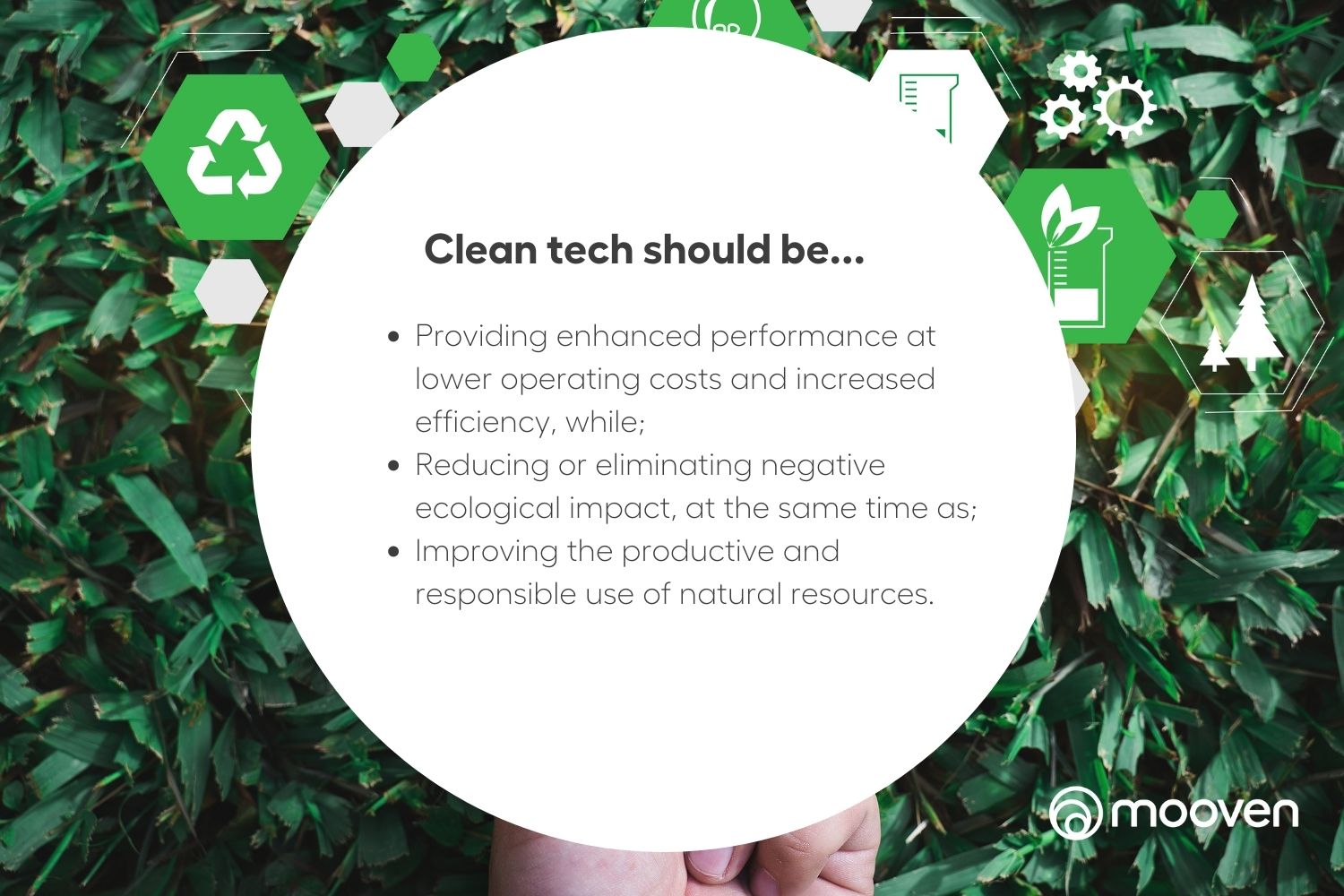
This definition supports the view that sustainability in the infrastructure sector is not just about emissions reduction. It's about taking a broader approach to understanding the social, environmental and economic impacts of any activity to achieve holistic outcomes.
Traveling along the change curve
There’s said to be significant space for accelerated innovation within roading, infrastructure, and construction. As one of the few remaining sectors that haven't been transformed by technology yet - think education post covid for a glimpse at what can change with real momentum - the opportunity is ripe to use innovation to drive more sustainable outcomes.
According to McKinsey's 'Imagining constructions digital future' article, the construction industry is ripe for disruption. For too long the industry has experienced productivity loss, with delivery teams forced to make compromised asset management decisions or work in ways they know could be improved but are unable to change due to misalignment with the status quo procurement and delivery paradigm.
Most of the decision-making, driving even multi-billion-dollar projects, has traditionally been made based on small samples of data used to infer observed behavior. The intention of these rules is to drive value for money or certainty of delivery - however, they are increasingly becoming poor proxies.
The inability to paint a true picture that understands and optimizes how projects are delivered, where and when investment should occur, or how to improve the useful life of existing assets has led to a huge amount of waste.
An example that brings this to life would be lane mile/kilometer targets. Many jurisdictions use these length targets with the intent to ensure they have a modern and well maintained network. A logical measure, however ultimately you could argue that it drives the need to complete a volume target at the expense of quality or total lifetime cost or infrastructure…
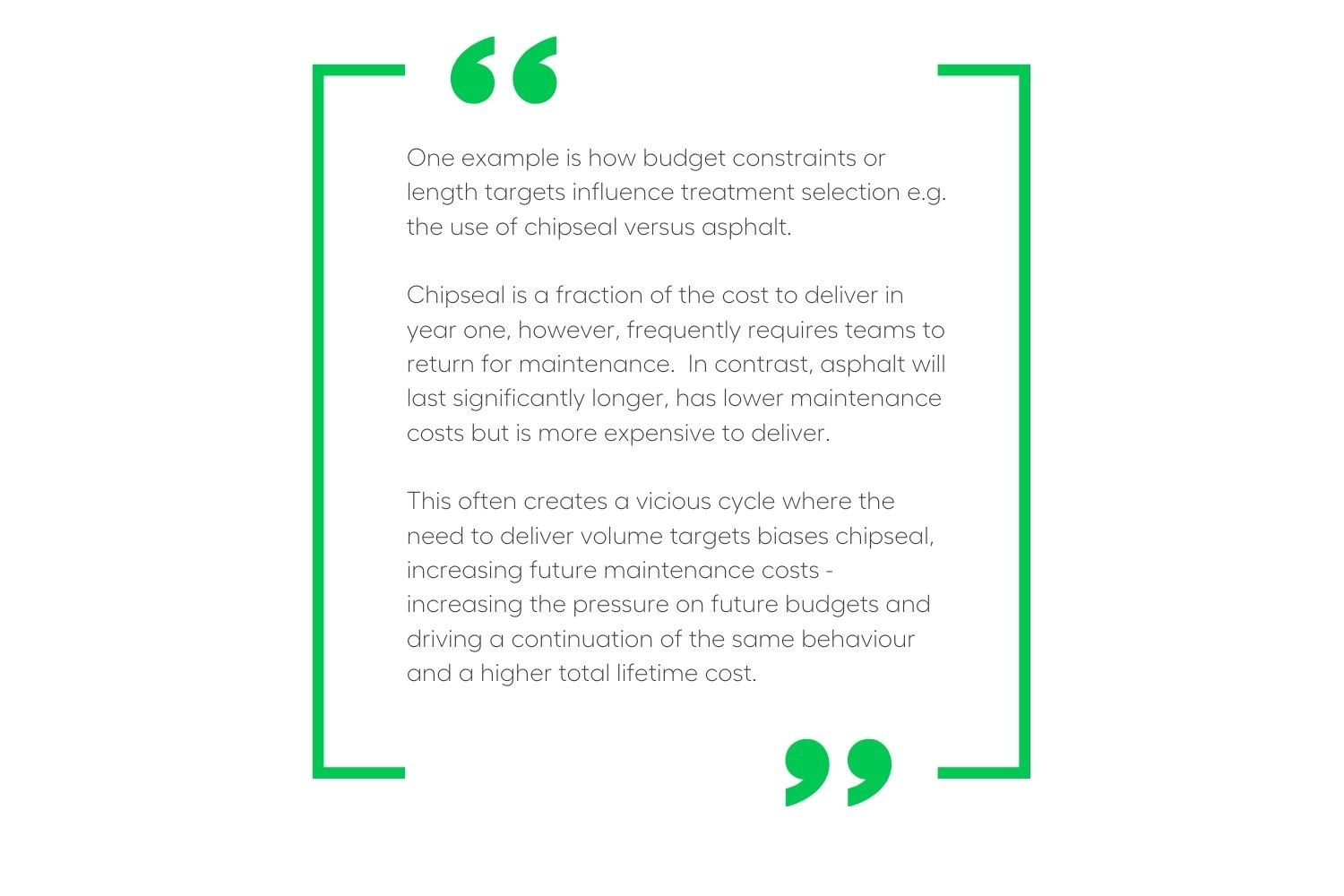
Oftentimes this can be fuelled even further by teams adhering to historical constraints such as resealing the road ahead of a true need - perhaps wear has been lighter than expected but it has now reached 20 years of age. An operating environment not conducive to thoughtful step change towards sustainable outcomes.
Solving real-world problems of carbon reduction and sustainable work practices
Through this challenging operating environment, we are still seeing many customers achieve great results in the area of carbon and emission reduction. Leveraging technology to make data-driven decisions around carbon reduction and sustainable work practices.
Sometimes the initial steps taken to improve aspects such as work windows (a win-win in terms of budget outcomes) can make a real difference to reduce the emissions of a project and its impact on the community. Furthermore, those results can 'start a movement' in your organization.
With access to data, construction organizations and stakeholders may find — for example — beginning roadworks even one hour earlier or finishing one hour later each day can shave weeks off completion time. Saving time, reducing emissions, reducing the economic cost of disruption, and improving safety… A seemingly small change that has now made a real difference to the social, environmental, and economic outcomes of that project.
When asked to articulate the role Mooven plays in sustainability and emissions reduction, I often speak to the below four areas of impact as the most visible and tangible. However, there are further sustainability impacts Mooven has in its holistic approach to infrastructure outcomes - with a purpose driven team who are partnering with customers daily to create more liveable, prosperous cities that are in harmony with their surroundings.
For the team at Mooven, we see ourselves playing a powerful enabling role for customers that can be categorized into these outcomes:
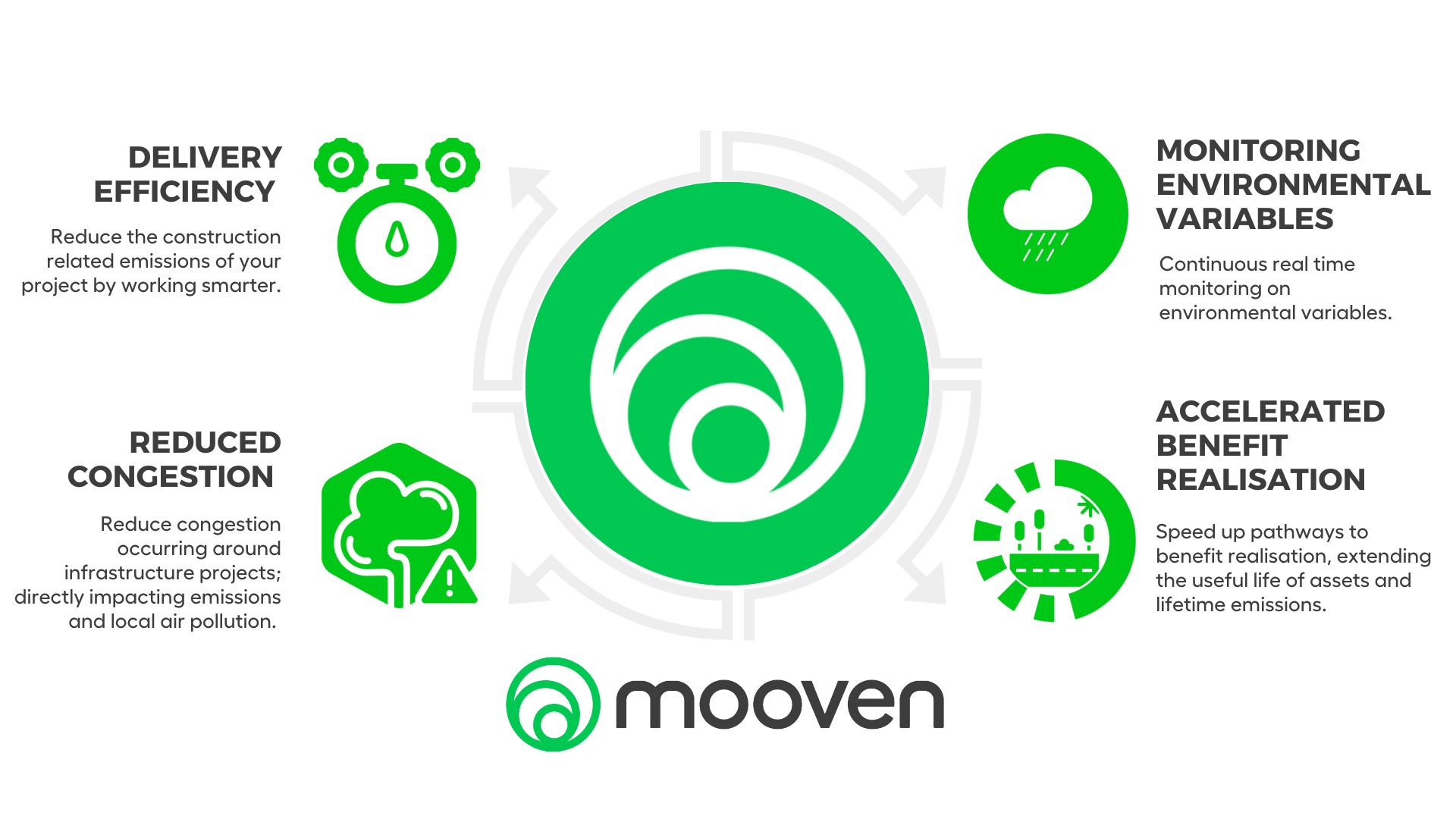

Delivery efficiency and construction related emissions
The emissions associated with building or maintaining infrastructure can be significantly reduced by working smarter. We often talk about the time and cost savings associated with tailoring 'when and how work is delivered' but the benefits also extend to greenhouse gas emissions.
Fewer shifts mean fewer trips to and from worksites - and selecting better routes for deliveries or soil removal from the site reduces turn-times and associated emissions. Increased output productivity here translates to lower emissions per metre delivered.

Reduced congestion around infrastructure projects
Stepping outside the bounds of projects, the ability to reduce the congestion caused by infrastructure delivery directly impacts emissions and local air pollution.
The direct emissions associated with traffic idling or moving slowly around worksites can be calculated. On large projects, this often impacts hundreds of thousands of vehicles a day over time.
Introducing the ability to compare congestion levels and the associated emissions gives delivery teams the ability to implement work practices that reduce the flow on impact to road users. This can be as simple as implementing dynamic, smart detours that assist motorists to avoid delays.

Continuous real-time monitoring of environmental variables
Clean technology and sustainability should also touch on factors like the health of local waterways, the impacts of dust on respiratory health, and noise. Luckily there has been an explosion of next-generation Internet of Things (IoT) devices that enable teams to cost-effectively monitor these variables.
Connecting them into a central disruption management platform like Mooven (i.e. layering in dust & particulate, noise and rain data), enables teams to make proactive, effective, and evidence-based decisions based on data to reduce the external impacts.
This drives seamless, transparent reporting/auditing of the environmental constraints on a project. More importantly, it promotes an agile approach to environmental compliance by proactively addressing potential issues and adjusting planned activity based real-time data.
…Moving away from blunt rules and handheld, periodic manual measurements that lack the integrated context to inform decision-making.

Accelerated benefit realization, extending the useful life of assets and lifetime emissions.
The final category looks at the benefits associated with the outcome and final use of infrastructure in our future smart cities - the ability to bring these forward to accelerate the benefits into the future.
Creating an accelerated pathway to the delivery of public transit and active mode assets will result in fewer vehicle miles/kilometers traveled.
It is through gaining a richer understanding of network performance, that data-driven insight can be used to make better treatment selections for these assets. This results in better quality assets that reduce travel emissions and vehicle repair costs - because avoiding re-work and the associated emissions from both delivery and additional materials used, has an even more powerful impact.
With a greater context of network performance, it is often possible to extend the useful life of assets by optimizing areas like signal phasing to reduce roading pressures.
What do these four categories have in common?
Arming teams that are responsible for infrastructure delivery with an evidence-based, true picture of the contextual and broad implications of emissions, economic productivity, and social outcomes is critical and has repeatable benefits.
You're on a journey, and this forges the pathway forward to using commercial delivery methods that encourage sustainability and lifetime benefit maximization.
A few practical cases from Mooven customers
Many of our customers have incorporated carbon reduction KPIs like these into their work practices, leveraging Mooven to continuously monitor and report on project impact. Proactive and retrospective reporting is useful for your evidence base, and plays an important role in real time decision making that mitigates any environmental risk. Most importantly it is also a powerful lever to encourage new thinking and alternative approaches to the way we work.
Customer A: Local air pollution and congestions reduction in action at Higgins
One example is a case study where Higgins reduced carbon emissions by understanding the highly congested times of the day, the team was able to schedule truck movements around peak traffic to minimize the impact of over 100 trucks per day idling in the local community.
By analyzing the timing of each truck movement and the performance of different route options, the team was able to save 15 minutes per trip - that’s 25 hours of driving per day.
Customer B: Smarter working windows with Downer
We’ve seen other great examples of how innovation in infrastructure delivery can offer improved holistic outcomes. For example, in Auckland, construction group Downer was expected to take 18 shifts over a five-week period to rehabilitate a busy commercial precinct on Manukau Road. Through the use of modern technology, the team could identify smarter and longer working windows, allowing them to complete the job in six shifts.
All in all, the project reduced greenhouse emissions by 27%, and a huge part of this success was because trucks weren’t needed to run for as many days as originally expected. Further, more uninterrupted time meant fewer breaks in the laying of asphalt, and this means longer lasting surfaces and fewer future repairs. The radically shorter delivery time also reduced the economic and environmental cost of disruption with residents spending less time in impact traffic.
These savings didn’t require a heavy investment in new equipment, they were realized by empowering existing teams with the information they needed to work smarter.
What happens when we look at another angle of sustainable infrastructure delivery? The environmental impact of:

Customer C: Environmental monitoring for dust considerations at Ward Civil
A practical example of turning an environmental constraint into a sustainable action is a complex roading upgrade Ward Civil was commissioned to complete in Parramatta, Sydney.
Due to space constraints at the worksite, Ward’s yard needed to be located in an adjacent residential suburb. Ward used Mooven to monitor live dust and noise conditions within the yard so they could proactively adjust their practices to minimize the environmental impacts on local residents.
The consideration of dust, noise, and sediment is often vitally important to communities and the health of surrounding ecosystems. Concerns and rules are often subjective and complaints are hard to validate. Switching to an operating environment with improved visibility changes these outcomes.
Is the status quo so hard to change?
Many a Mooven customer has flipped this coin to achieve real-time environmental insights and outcomes by continuously monitoring these aspects within their other worksite traffic information within Mooven.
This helps teams to manage community impact, easily validate and respond to complaints and work within environmental constraints at the same time. This can be used for transparent reporting and auditing, proactively addressing potential issues and adjusting planned activity based on predicted weather conditions.
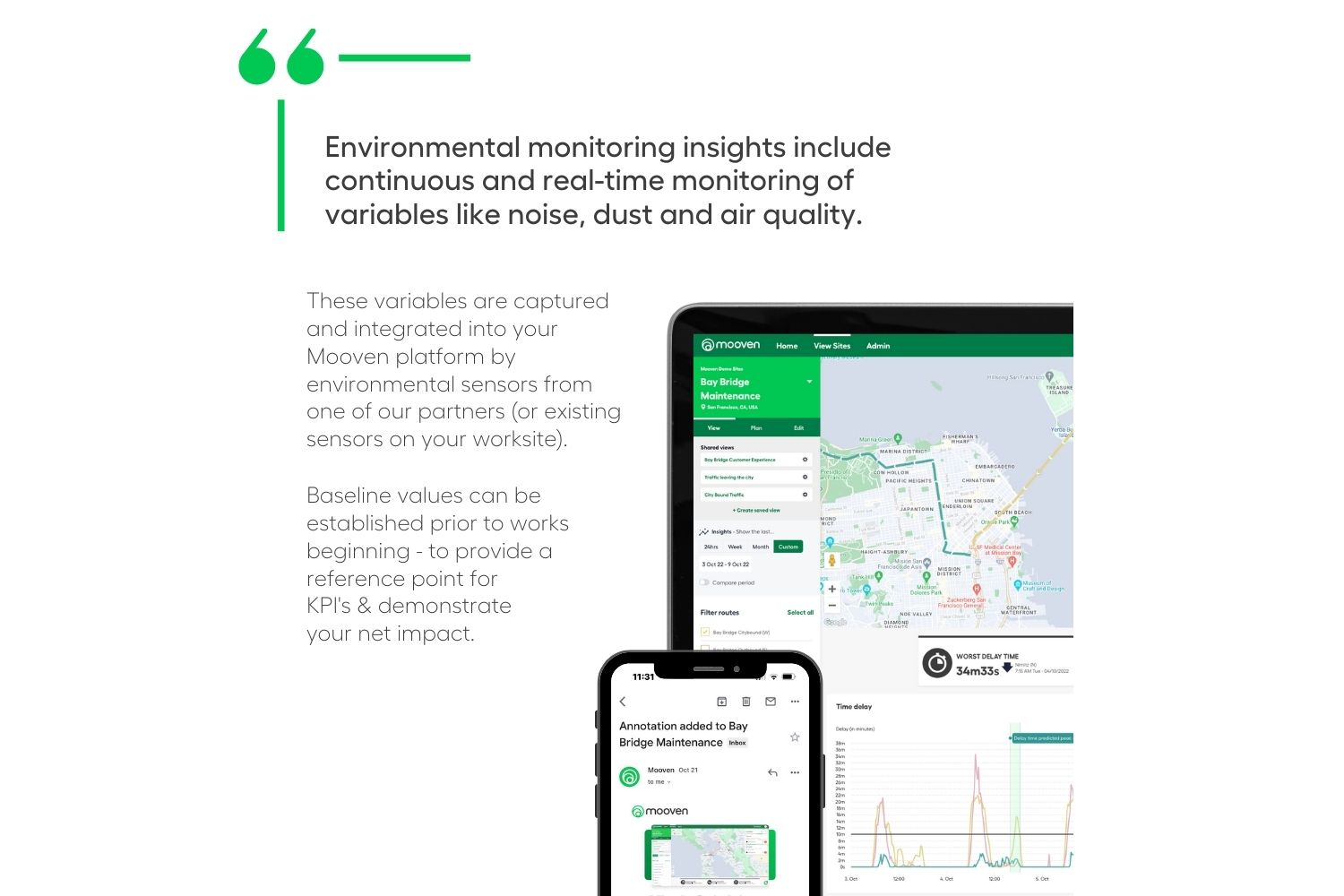
The inability to paint a true picture that understands and optimizes how projects are delivered, where and when investment should occur, or how to improve the useful life of existing assets has led to a huge amount of waste. The conversation needs to turn toward a deeper understanding of the full benefits of change and the costs associated with the status quo.
Recent analysis places infrastructure accountable for 70% of Australia’s national emissions, with 15% directly coming from the delivery and operations of that infrastructure. That's a significant impact and no doubt is similar in other comparable markets such as the United States, United Kingdom and America. Mooven published an article on the opportunity to drive more sustainable and environmentally friendly infrastructure in the Mandarin. It emphasized that reducing the footprint of the infrastructure sector is critical and public scrutiny over the ability of the sector to change has increased dramatically.
Keen to chat further?
I'm always eager to discuss sustainability further. Reach out if you are trying to unpick what it means for your business or upcoming program of work.
Serving for over six years as a board member of NZs Sustainable Business Network, an early career studying Environmental Economics and Econometrics and a recent project completed with the Nasdaq our Nasdaq Entrepreneurial Center cohort was tackling goals around Industry, Innovation & Infrastructure and Sustainable Cities & Communities (UN’s Sustainable Development Goals #9 & #11)... you'll find it's more than a customer outcome for myself and the wider Mooven team.
This is so important to us all and links to our purpose at Mooven to create more liveable prosperous cities that are in harmony with their surroundings - and we're excited to be here contributing to it (big and tiny steps included!).
- Micah
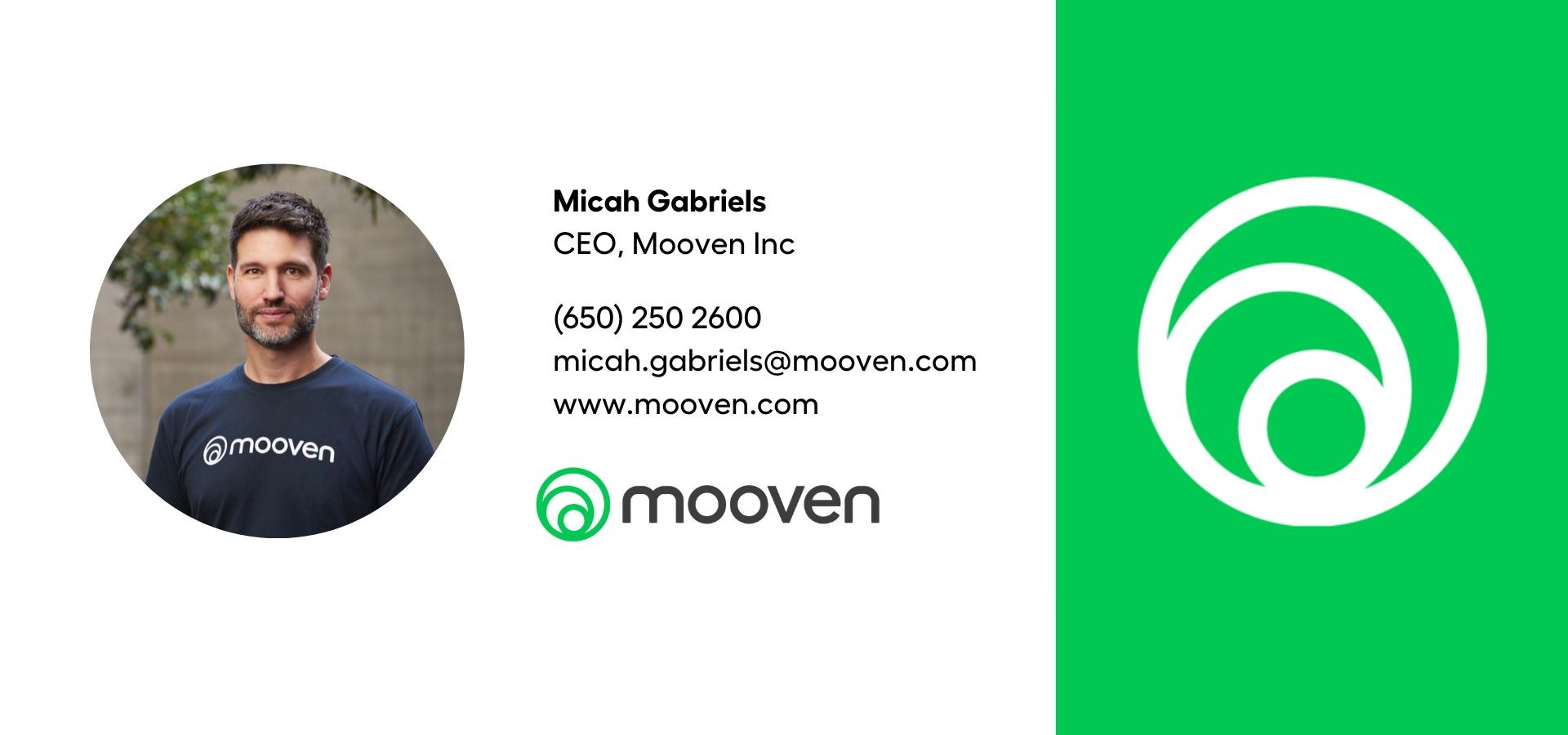

Smart VMS
Mooven releases self-service smart VMS
Date

Safety
Celebrating a risk-based approach to road safety
Date

Blog
Travel Time Monitoring for Road Infrastructure Projects
Date
